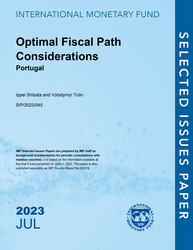
Optimal Fiscal Path Considerations: Portugal
Despite achieving a rapid reduction in the public debt-to-GDP ratio in recent years, Portugal's debt ratio remains relatively high at 113.9 percent of GDP in end-2022.
READ MORE...
Volume/Issue:
Volume 2023
Issue 045
Publication date: July 2023
ISBN: 9798400247231
$15.00
Add to Cart by clicking price of the language and format you'd like to purchase
Available Languages and Formats
| English |
Prices in red indicate formats that are not yet available but are forthcoming.
Topics covered in this book
This title contains information about the following subjects.
Click on a subject if you would like to see other titles with the same subjects.
Banks and Banking , Economics- Macroeconomics , Money and Monetary Policy , Public Finance , International - Economics , Fiscal stance , cycle stabilization , government deficit , government debt , Washington , D , C , International Monetary Fund , Portugal's debt ratio , model point , interest rate sensitivity , I , model detail , Real interest rates , Fiscal consolidation , Government debt management
Summary
Despite achieving a rapid reduction in the public debt-to-GDP ratio in recent years, Portugal's debt ratio remains relatively high at 113.9 percent of GDP in end-2022. This paper employs an analytical model to determine the appropriate trajectory for structural consolidation to sustain ambitious debt reduction over the medium term, taking into account the uncertainties in the economic landscape. The model points to a need for continued fiscal tightening between 2024 and 2028. Optimal consolidation would be higher under higher longterm interest rates, lower medium-term growth prospects, or increased market sensitivity to debt.
Copyright © 2010 - 2025
Powered by:
AIDC



